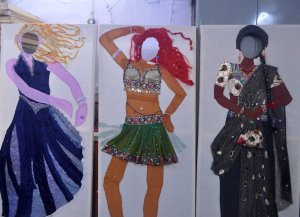We made three women out of our fantasies and stray fabric. We dreamt of dresses that we couldn’t wear, the women we couldn’t be. An actress in an elegant evening gown, a seductive dancer in a cabaret costume and a lady extravagantly dressed in a saree were just some of our aspirations that we pointed out in glossy fashion magazines.
On life size pieces of calico, we drew our dream girls. We gave them shape, movement and vision. We even made their bodies – pink, wheatish and brick brown. We sourced old clothes and deliberated on which of those would be the best to use. A royal blue salwar kameez with lace was chosen for the understated evening gown. A green salwar kameez with a golden border would transform into a bikini blouse and a mini skirt for the dancer. An old black saree would be embellished and draped on the classy lady.
Like busy Pygmalions we worked in the community hall and brought to life the lovely ladies. We named them after famous Bollywood actresses – Katrina, Helen and Rekha. Each name and each garment represented a different ideal – dressing differently from the prescribed cultural expectations, dressing sexily yet confidently, dressing in rich clothes and jewellery.
After the dresses, we gave them their accessories. Strips of golden cloth became bangles for Rekha in her saree. We even made a golden pouch for her and decorated it with buttons and cloth flowers. We put a band of pearls on Katrina’s wrist and shoes of gold, black and red. We had to make sure that Helen in her dancing attire was most decorated – sequin earrings, mehendi for her hands and anklets for her feet.
Before we mounted them on frames, we perfected their hair. Different shades of wool and beige fabric left Katrina looking like Botticelli’s Venus. A stray bit of nylon rope the colour of tomatoes was unravelled to make the hair for fiery Helen. For Rekha, an elegant plait made of black wool and garbage bags.
When they were complete, we mounted them on wooden frames. Our dream girls were resplendent, confident and dignified, irrespective of what they wore. We stepped into their shoes and for a moment knew what it felt like.
———————————————————————————————————————————————————————-
The dream girls resulted from a workshop conducted by Mary Whitaker in which participants recycled old clothes to create life size depictions of women in garments they felt they had no access to.




